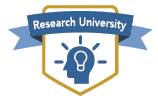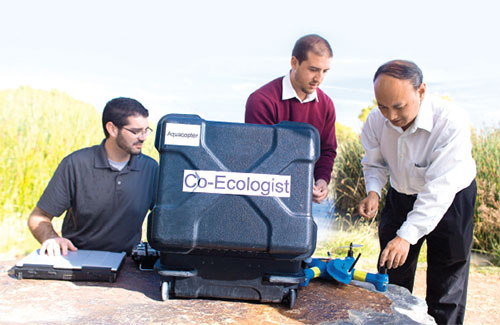First U.S. Research University Built in the 21st Century
 UC Merced is the newest campus of the world-renowned University of California system, and the first American research university built in the 21st century.
UC Merced is the newest campus of the world-renowned University of California system, and the first American research university built in the 21st century.
In fact, UC Merced is a hub for research in the Central Valley, and many students have the opportunity to conduct impactful research with esteemed faculty as an undergraduate.
UC Merced was ranked in 2019 No. 1 in the UC system for student participation in undergraduate research and creative projects.

Research at Our Core
At UC Merced, some of the world’s foremost scholars team up with students to focus on creating new products and technologies that will improve our daily lives. They collaborate to solve some of society’s most pressing issues, from disease to global warming, and everything in between. As an undergraduate, you will have opportunities to take your learning beyond the classroom and out into the field or in a laboratory.
- More info at research.ucmerced.edu.
Research Opportunities
The Undergraduate Research Opportunities Center (UROC) encourages and facilitates faculty-mentored undergraduate research projects and creative activities. The UROC website hosts a database of research opportunities, and workshops and events are ongoing.
Student-Led Projects
Research institutes such as the Center for Information Technology Research in the Interest of Society (CITRIS) strive to provide undergraduates with an opportunity for self-directed learning and professional development. Students are extensively involved in programs such as UC Sprouts, which is developing a curriculum to allow local elementary school students to create an edible garden. In the Constant Current Electric Vehicle project, students are working on a potentially more efficient electric motor. Tire manufacturer Pirelli supported students in the Pirelli Project, in which they generated a discovery report on emerging trends in the automotive vehicle industry that could affect the tire environment.
Solutions for Society
Innovate to Grow is a yearly celebration of student ingenuity. In a way, it’s a science fair for college students, where they pitch their ideas to businesses and nonprofit organizations to help solve the challenges they face.
- Innovation Design Clinic: Teams of graduating seniors and organizations collaborate, discover solutions to common problems, create and streamline networking, and increase both radical and incremental innovation.
- Engineering Service Learning: Teams of students work on real-world projects for nonprofit community partners. Past teams have used drones to detect illness in crops and made students in Merced County excited about the sciences.
- Mobile App Challenge: Over the course of three months, students design, prototype and pitch their ideas for mobile applications that address a need in society. One team recently got offered summer internships at PG&E for creating an app called UpNote, which helps students study for classes.
Across All Disciplines

- Professor and biologist Miriam Barlow helped develop a method to restore the efficacy of antibiotics and help doctors deal with resistant bacteria.
- Adjunct Professor Gabriela Loots is studying why certain cancers prefer to metastasize to bone. Loots is trying to identify, characterize and potentially exploit the information packaged in different types of extracellular vesicles to determine if they can distinguish aggressive forms of breast cancer that rapidly spread in the body.
- Professor Danielle Edwards was part of a team of researchers that made a discovery about two groups of giant Galapagos tortoises — they are actually two different species.
- Undergraduate mechanical engineering student Rebecca Quinte worked on a project with Professor Andrea Joyce that aims to shoo away leaf-footed bugs, insects that feed on the seeds of crops — research that could end up benefitting farmers in the Central Valley and beyond.
Research Facilities
- Imaging and Microscopy Facility (IMF)
- Light Microscopy and Crystallography Modeling Center
- Mechanical Test Laboratory
- Merced Nanomaterials Center for Energy and Sensing (MACES)
- Sierra Nevada Research Institute (SNRI) Environmental Analytical Laboratory
- Stable Isotope Laboratory
- Stem Cell Instrumentation Foundry (SCIF)
- UC Natural Reserve System

Institutes and Centers
- Center for Computational Biology
- Center of Excellence for the Study of Health Disparities
- Center for Information Technology Research in the Interest of Society (CITRIS)
- Health Sciences Research Institute (HSRI)
- Merced Nanomaterials Center for Energy and Sensing (MACES)
- Resource Center for Community Engaged Scholarship (ReCCES)
- Sierra Nevada Research Institute (SNRI)
- Small Business Development Center (SBDC)
- University of California Advanced Solar Technologies Institute (UC Solar)



